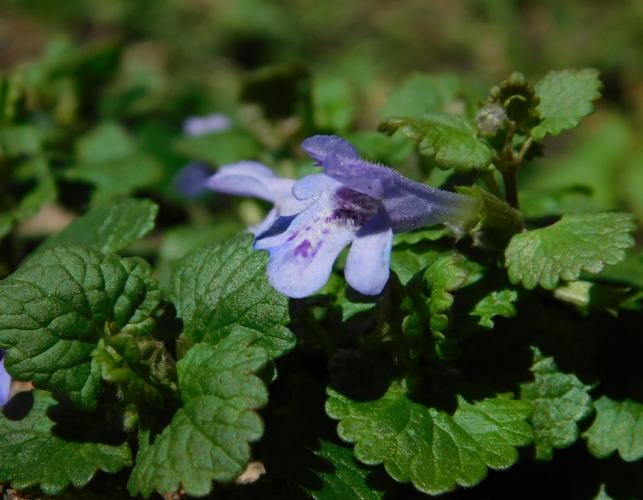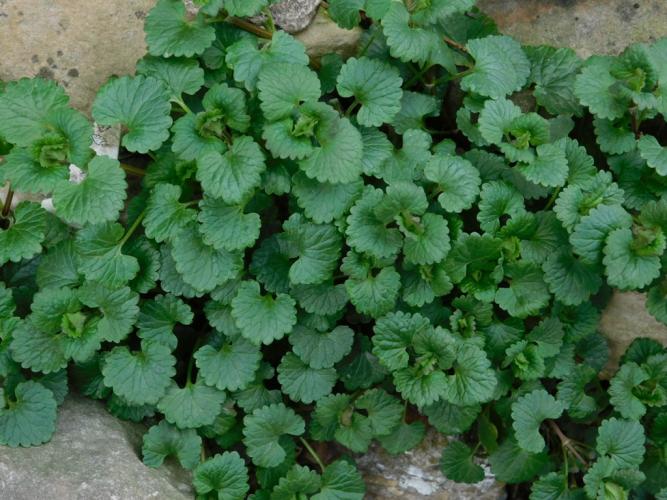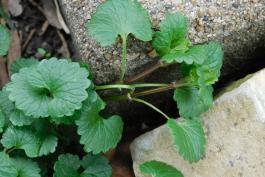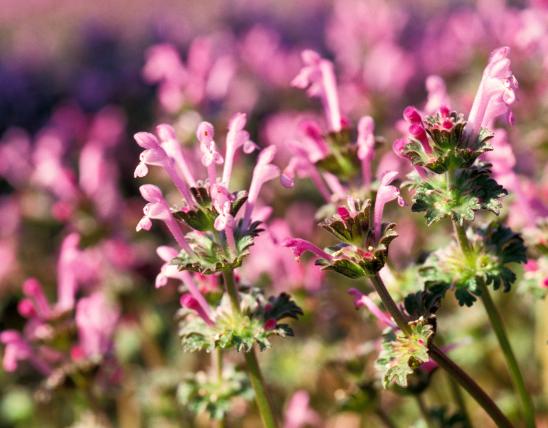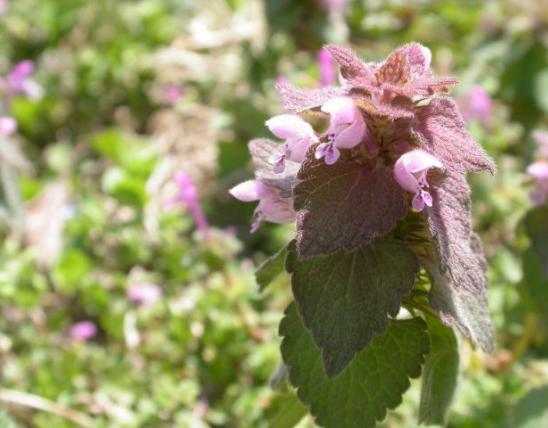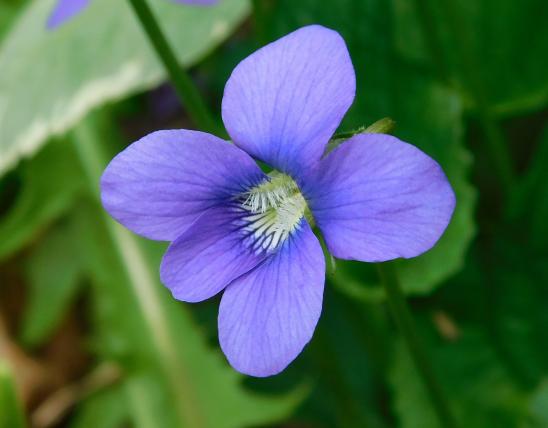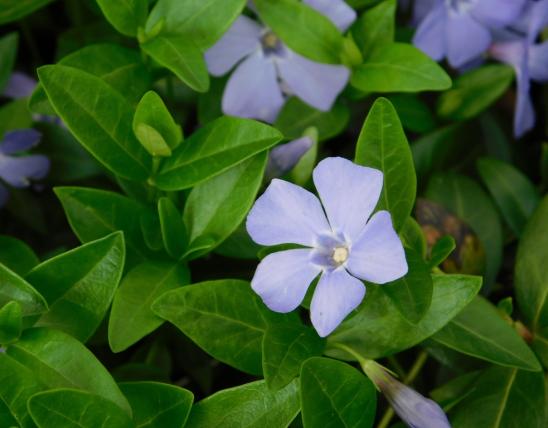
Ground ivy is a perennial, creeping, nonwoody plant that often forms loose mats. A native of Europe and Asia, this member of the mint family has been introduced nearly throughout the United States. It is widely considered a lawn and garden weed.
The creeping stems are square in cross-section and take root at the nodes.
Leaves are opposite, with distinct leaf stems; blades are round or kidney-shaped, with scalloped or bluntly toothed margins. The foliage produces a mildly unpleasant, somewhat minty odor when crushed. Hairiness varies from glabrous to sparsely hairy.
Flowers occur in the leaf axils in clusters of 2–6 flowers per node. Petals are purplish blue to purple and fused into a funnel-shaped tube, ⅜–⅝ inch long, in the typical 2-lipped mint-family configuration. The upper lip is notched at its broadly rounded tip; the lower lip has a pair of smaller lateral lobes plus a much wider central lobe; the central lobe is notched at the tip and usually has white and darker purple mottling or spots and a beard of fine hairs near the opening of the throat. Blooms March–July.
Fruits are tiny, dry, egg-shaped nutlets (1–2 mm long); 2–4 per flower; brown.
Similar species: Other plants that commonly occur as weeds in lawns and gardens include henbit, dead nettle, and Persian speedwell, but none of these have creeping stems that function as stolons, taking root at the nodes.
Stem length: typically 15 to 30 inches. In the course of a growing season, a stem runner can grow nearly 7 feet.
Introduced, scattered nearly statewide, but mostly absent from the western portion of the glaciated plains of northern Missouri.
Habitat and Conservation
Occurs in bottomland forests, mesic upland forests, banks of streams, rivers, and spring branches, and bases of bluffs; also lawns, gardens, railroads, roadsides, and shaded, disturbed areas.
Ground ivy is native to temperate regions of Eurasia and spread nearly throughout temperate North America in the 1800s. Today, it is widely considered a stubborn, troublesome weed of lawns and gardens. In some regions it is considered invasive in natural habitats.
Ground ivy spreads not only by cuttings that take root, but also by its tiny seeds (nutlets) that produce an adhesive mucilage when moistened.
Ground ivy was first reported in North America in the eastern United States in 1814. It might have arrived on our continent as a contaminant with crop plants or seeds, but it might also have been brought from Europe intentionally as an ornamental plant or for use as an herb or medicinal plant. It probably had numerous introductions. From the east coast, it spread westward at a rate of about 19 miles a year. Today, it occurs nearly throughout temperate North America. It is less common in the Great Plains and the Southwest, where the habitat is less suitable for it.
Humans have undoubtedly assisted its spread. The 1800s was the era of steamboats, and many of the first records of the plant in the Midwest and South are along major rivers. In addition to moving cuttings of the plants (which readily take root to form new populations) and seeds, people also altered the environment in ways that increased the suitable habitat for ground ivy. The earliest specimen found in Missouri was collected in 1868 along the Meramec River in St. Louis County.
Status
Nonnative wildflower, introduced to our continent from Europe in the early 1800s. Widespread. Widely considered a weed of lawns and gardens; it often outcompetes turf grasses. Considered invasive in some regions.
Human Connections
Ground ivy is considered a nuisance in lawns and gardens, and in disturbed floodplain habitats. It is capable of growing up to 7 feet in a single year and can continue to elongate under the leaf litter during the winter.
Ground ivy is difficult to control, because even just small portions of roots or stems left behind by hand-weeding can regenerate into new plants.
In Europe, the plant was used by the Saxons in brewing ale before hops became available in the late 1400s. Ancient names for the plant include alehoof, tunhoof, and gill-over-the-ground (tun and gill being units of liquid measurement).
There have been reports of livestock becoming poisoned after ingesting large quantities of ground ivy fresh or in hay, though the causal toxins remain unknown. Apparently, horses are especially susceptible.
Ground ivy was used in European folk medicine to treat a variety of ailments. People have eaten it as a salad green or cooked, but it is unclear whether it is safe for people to consume in large quantities.
Ecosystem Connections
When ground ivy invades natural plant communities, it can outcompete native plants and degrade the ecosystem. Because it tolerates shade, it is an especial threat to woodland and forest communities and may dominate the groundcover layer of vegetation.
A wide variety of bees, flies, and butterflies visit the flowers for nectar, pollen, or both. The caterpillars of the false crocus geometer (Xanthotype urticaria) feed on the foliage of ground ivy (as well as several other kinds of plants).
Occasionally, you may see one or a few green or pinkish, often hairy, rounded blobs developing on the stems or leaves of a ground ivy plant. These wartlike growths are galls caused by an herb gall wasp, Liposthenes glechomae. The mother wasp deposits eggs into the ground ivy, and the plant forms the gall in response to the larva developing within its tissues. Like its host plant, this gall wasp is native to Europe and is not native to North America.
